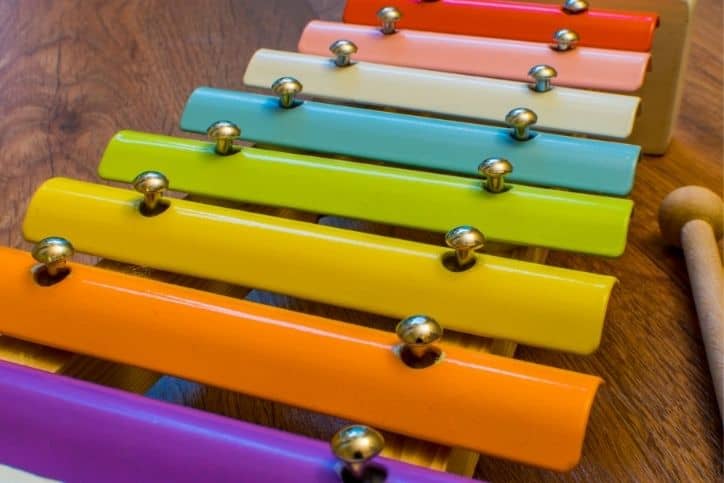New Instrumental Scheme For KS2
Written by Elizabeth Stafford
Published on 17th November 2021
Last Updated: 30th July 2024
Written by Elizabeth Stafford
Published on 17th November 2021
Last Updated: 30th July 2024

This year, Kapow Primary has been working with Music specialist Dr Liz Stafford to develop a brand-new instrumental scheme for KS2, which can be used alongside or as an alternative to the Kapow Primary Music scheme of work. In line with the DfE’s 2021 Model Music Curriculum guidance, Kapow Primary’s KS2 whole-class instrumental scheme is a progressive collection of 30 lessons, teacher videos and accompanying staff notation teacher skills videos.
Each unit of lessons focuses on music from a different part of the world and features a bespoke piece of music composed specifically for the scheme, including sheet music, performance and backing tracks.
Whole-class instrumental teaching has been around in England since 2003, but has recently made its way into other areas of the UK such as Wales, and has also been adopted by other countries across the world, as far away as Australia! The whole class instrumental teaching approach is essentially delivering the primary music curriculum through a particular musical instrument — in Kapow Primary’s case, tuned percussion.
The recently published Model Music Curriculum reiterated the importance of schools having a whole class instrumental strand to their curriculum, and suggested that this should run alongside ordinary music lessons. This was indeed the original intention of these schemes when they were invented, however pressures of time often mean this is not possible, so the Kapow Primary instrumental scheme is designed to work either instead of or alongside the main music scheme of work.
In support of the movement to decolonise the curriculum, and to make it more representative of the multiple communities that our schools serve, the Kapow Primary instrumental scheme has been designed to introduce pupils to a range of musical styles from across the world without making comparisons or value judgements about their ‘worth.’ The musical styles covered are inspired by music from around the world and should be taught in the following order:
The non-statutory Model Music Curriculum puts a much greater emphasis on the skills of reading music notation and learning a musical instrument over a sustained period of time than the national curriculum does. The Kapow Primary instrumental scheme has been designed to reflect these priorities, providing an alternative to the main scheme of work for those schools who decide that they want to align more closely with the Model Music Curriculum.
The instrumental scheme covers all the Model Music Curriculum requirements for Year 3, and the staff notation and instrumental performance requirements for all of Year 4, and most of Year 5.
Many schools are moving towards a knowledge-rich approach to the curriculum, and the recent Ofsted Music Subject Research Review has outlined the processes behind developing different types of knowledge within the music curriculum. Ofsted places emphasis on repetition to build procedural knowledge (skills-based) in small steps, which then become automatic, allowing pupils to focus on higher-level skills.
The Kapow Primary instrumental scheme includes a progressive set of six pieces of music to learn, each of which builds on the instrumental and performing techniques and staff notation knowledge of the previous piece. Pupils are given time to focus on each piece for a full five-week unit so that through repetition and incremental learning, they can develop and secure their musical skills and knowledge. We also provide knowledge organisers, knowledge catchers, worksheets, and end-of-unit quizzes to help pupils develop their declarative knowledge over time.
Like all of Kapow Primary’s schemes, the new instrumental scheme includes lesson plans, assessment proformas and guides, teaching resources and teacher CPD videos. What’s new with this scheme is that it also includes original music written specially for Kapow Primary, in styles such as Salsa, Calypso, Bollywood, Gamelan and more!
The instrumental scheme will work with any tuned percussion instruments, although xylophones, glockenspiels, metallophones, or marimbas will work best. Additionally, you will need a range of untuned percussion instruments, and you’ll also be using your voices! The scheme has been designed to work with two children sharing an instrument if you’re not able to provide one each. Additional parts have been provided for other instruments, so that if you have children who are having small group or 1-2-1 instrumental lessons, they can learn the pieces on their instrument with their instrumental teacher and then add these parts into the final class performance.
The instrumental scheme covers the requirements of the national curriculum and Model Music Curriculum at Year 3 level. In addition, the scheme covers the staff notation and instrumental performance requirements set out in the Model Music Curriculum for Year 4 and most of Year 5. You can therefore use it to develop pupils’ instrumental and music reading skills at any stage of KS2, though it will work best in Year 3, particularly if you have already completed the Kapow Primary KS1 Music scheme.